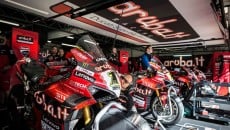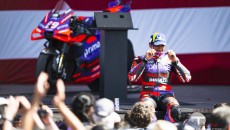In motorsport there is still room for ingenuity and good ideas and the winter tests have shown it. In Formula 1, Mercedes started the ball rolling by transforming the steering wheel into a ‘dual axis steering system’ to vary the convergence of the front wheels, while in MotoGP, as is now tradition, Ducati remained one step ahead of everyone else with their 'variable geometry’ bike.
It is actually not new this winter, as the system was tested by Jack Miller for the first time last year in Thailand and in the race at Phillip Island, then the factory riders also wanted to get their hands on it.
Their rivals were the first to notice the development: "I could clearly see that Miller's bike is lowering under acceleration". Of course, they were right, because this is precisely the function of the system. Look at the photo above, taken during the recent tests in Qatar, and you will immediately notice how low the rear of the Desmosedici is, much lower than a normal bike under acceleration. Just note how low the 'spoon' that almost touches the asphalt is.
The regulations do not prohibit it, but they don’t allow the system to be automated electronically, so the rider must activate and deactivate it manually. This is the function of those two buttons that appeared on the left half handlebar, of cycling origin. On mountain bikes, in fact, the rear shock absorber locks uphill and on asphalt, to gain traction.
In MotoGP, by lowering the bike you put more load on the rear and change the centre of gravity, which guarantees more grip and allows you to put more horsepower down. This is vitally important with bikes now close to having 300 hp and in fact, last year, again in Borgo Panigale, they invented the 'spoon' to take advantage of a little downforce thanks to airflow in a usually neglected area of the bike and to have greater load on the rear wheel. Maybe, at the same time, cooling it a little as well.
Gigi Dall’Igna and his men are masters in this field and in recent years their rivals have often found themselves caught napping, being forced to play catch-up and copy these ‘Made in Bologna’ solutions - when they have not succeeded in getting them banned.
From wings to the 'salad-box': Dall’Igna’s top hat
It must be remembered that Ducati has always had the ‘vice’ of innovation, even before the arrival of the Veneto engineer. Dall'Igna must take the credit for paving the way for the study of aerodynamics to increase load on the bikes by introducing the now famous 'wings'. The idea dates back to the 1970s, when MV tried them without success, but the first experiments in MotoGP were thanks to Filippo Preziosi and in 2010, during the Sachsenring GP, Casey Stoner tried some appendices on his Desmosedici. Even Valentino Rossi, in his Bologna years, experimented with them.

The project was then shelved, until 2015, when Dall’Igna took it to another level. What followed is recent history, with the other manufacturers that tried first to abolish them, then to limit them, and finally there was nothing left for them to do but adapt. So much so that now there is no MotoGP bike that does not have spoilers and appendages on its fairing.
Research then moved to the bottom of the bike with the 'spoon', a spoiler applied in front of the rear wheel. Yamaha had done something similar but with a completely different function: it was used in wet weather as a deflector, so that the water raised by the front wheel did not directly affect the rear one.
At Borgo Panigale they understood that that particular area was interesting to find greater aerodynamic load on the rear wheel. The function of that appendix, officially, was to cool the tyre but, in this case, the 'secondary' effects were much more interesting than the 'primary' ones. To clean the air flow that affects it, special covers were also designed on the front wheel, which match the rear covers.
Ducati’s rivals took them to court to ban this device but were defeated.
It is impossible not to mention the 'salad-box', that is, a sort of trunk in the lower part of the Desmosedici's tail fairing. The nickname came from a comment by the test rider Michele Pirro, whose answer to those who asked him what it was for, was: "to put a snack inside".
It actually contains a mass damper, although Ducati has never revealed anything about this system. The first experiments date back to 2014, when two cylinders sprouted from the tail. In this case, none of Ducati’s rivals copied this system, although Honda tried a similar solution in some tests last year.
Finally, we arrive at the 'holeshot' system, developed last year for race starts. By means of a lever on the upper triple clamp, the riders lowered the rear of the bike, to have greater weight on the rear when starting. Here, too, there was a change in the centre of gravity, with an influence also on the bike’s tendency to wheelie.
In this case their rivals have adapted the system without any controversy and the first was Aprilia, which however only acted on the front fork. A system in use in motocross and Supermotard, where the riders, by means of a hook, compress and lock the front fork for the start. In these winter tests, however, Suzuki, Honda and Yamaha have all experimented with solutions similar to those of Ducati.
Bologna engineers, however, decided to evolve this system by using it not only at the start of the race. Conceptually, in fact, the holeshot 2.0, as our British colleagues call it, is nothing more than the system used at the start with a mechanism that allows you to activate and deactivate it even on the move.
From the 'dachshund' to the start & stop: you can’t win all the time
As we have already mentioned, Ducati have a tradition of more or less successful inventions. Two of these date back to the time when the technical director was Filippo Preziosi.
The first is very reminiscent of Dall'Igna's recent 'variable geometry’ system. Even in that case the rear of the motorcycle lowered, but during braking. The bike squeezed and stretched and was nicknamed the 'dachshund'.
The riders confirmed that by doing so it was possible to delay the braking for a few meters, but then other problems arose. The front wheel, in fact, was unloading and it was too easy to lock it. The idea was then put back in the drawer.
The same thing happened to the 'start & stop' system, which is reminiscent of the one now found on many cars, which switches off the engine when you stop at traffic lights and engages neutral, and then turns it back on when first gear is engaged.
The idea was to reduce fuel consumption by turning off the engine when braking, and then restarting it when the rider reopened the gas. On paper it could have worked, but when the riders tried it, they rejected it. The reignition was very abrupt and riding with that system was almost dangerous.
At Ducati they have no fear when it comes to looking for new development paths, so we are curious now to know what they are working on for the future…











